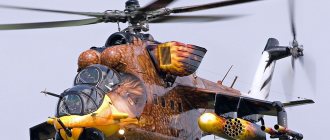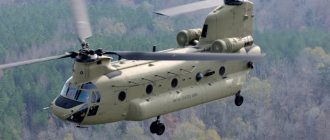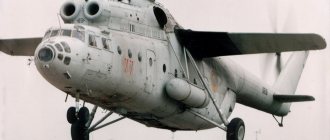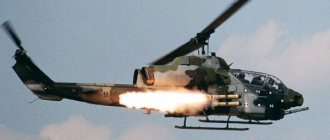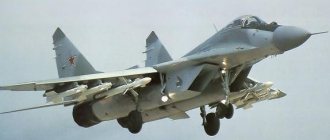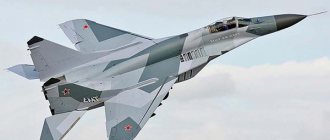In June 1955, she created a helicopter project for the US Army, designating it Model 204. The new helicopter received the designation H-40 (UH-1) and the name “Iroquois”. The first order was for three prototypes of the KhN-40. The prototype helicopter took off on October 22, 1956 and was used for testing and modifications. Immediately before the first flight, 6 pre-production YH-40 samples were ordered and all were delivered in August 1958.
Helicopter UH-1 Iroquois - video
The nine final pre-production UH-1A helicopters entered production on June 30, 1959, followed by 74 production units. These machines had dual controls and were used as trainer helicopters for instrument flight. For the first time they began to be used en masse in Korea. UH-1A helicopters were among the first US Army helicopters to operate in Vietnam. The helicopter's distinctive external feature is a stabilizing rod located above the main rotor at right angles to its two blades, as well as small elevators attached to the rear fuselage. The tubular skid chassis was ideal for general purpose operations. The cabin could accommodate two crew members and six passengers or two stretchers.
The power plant includes the Avko Lycoming T53-L-1A turboprop engine with 522 kW/700 hp, making the Model 204 the first aircraft to be equipped with a turbine. The improved version of the UH-1B (more than 700 copies built) initially had an Avko Lycoming T53-L-5 engine with a power of 716 kW/960 hp, and a later production model received a T53-L-11 engine with a shaft power of 820 kW/1100 hp Other improvements to the helicopter included redesigned rotor blades and an enlarged cabin capable of accommodating two crew members and seven passengers or three stretchers.
Beginning in the fall of 1965, the UH-1B Iroquois helicopter was replaced in production by the UH-1C helicopter, which had a “hinged” propeller with wide blades. This new main rotor provided a slight increase in speed and increased maneuverability. Several UH-1A helicopters. operating in Vietnam, were armed with a rocket pod and two 7.62 mm machine guns for close-in support. The success of this helicopter led to many UH-1Bs being used armed primarily with four side-mounted 7.62 mm machine guns or two symmetrically positioned pods, each containing 24 missiles. Other military variants of the Model 204 included the UH-1E helicopter for the United States Marine Corps. equipped with a winch for lifting people, a main rotor brake and electronic equipment. The first helicopter was delivered on February 21, 1964, and from October 1965, a new main rotor with hinged blade suspension began to be installed on production vehicles.
The UH-1F helicopter for the US Air Force, with a General Electric T58-GE-3 962 kW/1290 hp theater engine, had a larger diameter rotor and was able to accommodate a pilot and 10 passengers. Based on the UH-1F, a similar training version, the TH-1F, was created. The NN-1K helicopter was developed for the US Navy and is similar to the UH-1E helicopter. but with the T53-L-13 engine with a power of 1044 kW/1400 hp, and the TH-1L and UH-1L helicopters (trainer and general purpose) with the T53-L-13 engine. Three UH-1M helicopters were equipped with night vision equipment.
The Model 204B helicopter was built for civilian use and military export. It had 10 seats, a larger diameter rotor than the UH-1F, and a T53-L-11 engine. Model 204B and UH-1 were built by Japanese. and in 1967, this company introduced the Fuji-Bell 204B-2 helicopter, which differed from the Model 204B in a more powerful engine and a pulling tail rotor. The success of the UH-1A/B Iroquois helicopters convincingly proved that there were few errors in the basic design of these devices. The dedicated UH-1A/B helicopter was continuously refined and equipped with ever more powerful engines. At the beginning of 1960, it proposed an improved version of the Model 204 helicopter design with a longer fuselage, additional space in the cockpit, providing accommodation for a pilot and 14 military personnel or six stretchers, or up to 1814 kg of cargo. In July 1960, testing began on seven helicopters under the military designation YUH-1D (they were designated by the manufacturer as Model 205). The first of these helicopters flew on August 16, 1961 and, after successful flight testing, entered serial production. The first helicopter, designated UH-1D, was delivered on August 9, 1963.
The power plant of this type of machine was the Avko Lycoming T53-L-11 turboprop engine with a shaft power of 820 kW/1100 hp. The standard fuel capacity of 832 liters could be supplemented by two internal auxiliary fuel tanks, increasing the maximum fuel capacity to 1,968 liters. Large-scale production of UH-1D helicopters was launched for both the US Army. and for the armed forces of other countries. in West Germany it built 352 helicopters under license.
After the UH-1D Iroquois helicopter, the identical UH-1H Iroquois was launched into mass production with an Avko Lycoming T53-L-13 engine with a shaft power of 1044 kW/1400 hp. Delivery of UH-1H helicopters to the US Army began in September 1967, and this variant was the last in mass production. In addition, UH-1H (9 vehicles) were sold to the New Zealand Air Force and 118 helicopters were manufactured under license in Taiwan. Variants of the UH-1H helicopter included the CH-118 (originally CUH-1H) helicopters built for the Canadian Air Force. the first 10 of which were delivered on March 6, 1968, and NN-1N - rescue helicopters. 30 of which were ordered by the USAF on November 4, 1970 (deliveries completed during 1973). UH-1D/H helicopters have been used extensively for a wide range of missions in Southeast Asia, particularly in Laos, Cambodia and some remote areas of South Vietnam. A small number of UH-1H helicopters, designated EH-1H, were selected for electronic countermeasures; aircraft with improved systems began to be delivered in 1981.
In accordance with the US Army program to develop the SOTAS system (system for detecting and intercepting targets before entering the enemy's air defense zone), four UH-1H helicopters were modified for testing. Their task was. to receive radar data on movements on the battlefield, transmit it to the ground and provide ground command with information about the tactical situation. The US Army intends to keep the basic UH-1H helicopter in wide-scale service until the early 21st century. In connection with such plans, the existing fleet of UH-1H helicopters can be considered the subject of an improvement program, according to which modern equipment and equipment should be added.
» also mass-produces a commercial version of the UH-1H helicopter under the designation Model 205A-1. It is equipped with an Avko Lycoming T5313V turbocharger with a shaft power of 1044 kW/1400 hp, throttled to 932 kW/1250 hp. The normal fuel supply is 814 liters, but can be increased to 1495 liters. Particular attention is paid to the internal design to quickly convert the helicopter into cargo, ambulance, administrative, flying crane or search and rescue versions. Maximum capacity: pilot and 14 passengers. in Italy it also built Model 205 helicopters under license under the designation AB.205A-1, similar to the production model. The buyers of these helicopters were the Italian Air Force and some other countries. The Fuji-Bell Model 205A-1 helicopter was produced in Japan.
On May 1, 1968, an agreement was reached with Pratt & Whitney Aircraft to continue development of a new helicopter based on the Model 205 UH-1H Iroquois helicopter. The first of ten such devices entered service with the Canadian Armed Forces on March 6, 1968 under the designation CUH-1H. Its power plant was the Avko Lycoming T53-L-13 turboprop engine with a shaft power of 1044 kW/1400 hp. However, it was decided to use two theaters. Improvements led to the creation of the Model 212 military helicopter. The power plant of the RT6T Twin-Pack Canadian (PWAC) helicopter was technically revolutionary. It consisted of two theaters of operations. installed side by side and rotating the main rotor shaft through a gearbox. The shaft power output of the first production helicopters was 4.66 kW/kg, while for the improved Lycoming T53 theater it was 4.19 kW/kg.
There was another very significant advantage: when installing the RT6T-3 engine on a Model 212 helicopter, the power output during takeoff was limited to 962 kW / 1290 hp. In the event of a malfunction of one of the two turbines, torque sensors located in the collecting gearbox transmitted a signal to the working turbine, and it began to produce shaft power in the range of 764 kW/1025 hp. up to 596 kW/800 hp for emergency or continuous operation respectively. Deliveries of military helicopters Model 212 under the designation UH-1N to the US Air Force were carried out in 1970, and to the US Navy and Marine Corps in 1971. The first CUH-1N helicopter (SI-135) was transferred to the Canadian Armed Forces on May 3, 1971 It had an all-metal fuselage structure. postless ski landing gear, two-bladed all-metal semi-rigid main rotor and two-bladed tail rotor.
Eight Model 212 helicopters were delivered to China in 1979. Helicopters Model 212 under the designation AB.212 were produced in Italy under license. The first deliveries of these machines took place in 1971. The anti-tank version AB.212ASW had a reinforced helicopter frame, installed deck landing gear and a PWAC RT6T-6 Twin-Pak theater engine with a shaft power of 1398 kW/1875 hp during takeoff
Vietnam War
Due to its wide range of functionality, the Huey has become a symbol
Vietnam War. Throughout the conflict, the UH-1 helicopter flew 9,713,762 hours. Three main Huey configurations were used in the Vietnam War:
- Slick: transport of troops or cargo. Armament: M60 on each side of the fuselage;
- Gunship: ground support or escort. Armament (depending on time, tasks and versions): two 7.62x51 mm machine guns connected in parallel on each side of the fuselage; a grenade launcher mounted under the aircraft's nose and two 70mm triple rocket launchers;
- Medevac: sanitary evacuation.
A total of 3,305 UH-1 helicopters of all types were destroyed by the enemy or accidentally lost during the war.
The first helicopter aerial victory occurred on January 12, 1968, when a UH-1D crew fired on two aircraft.
Performance characteristics of the UH-1 Iroquois
— Entered into service: 1959 — Total built: >16,000 — Modifications: UH-1N Twin Huey, Bell 204/205, Bell 212, Bell 214, UH-1Y Veno
UH-1 Iroquois crew
— 1-4 people
Capacity UH-1 Iroquois
- 14 soldiers or 6 stretchers and 1 escort
Dimensions UH-1 Iroquois
— Main rotor diameter: 14.63 m — Tail rotor diameter: 2.59 m — Fuselage length: 12.77 m — Height: 4.42 m
Weight UH-1 Iroquois
— Empty: 2363 kg — Maximum take-off weight: 4310 kg — External load weight: 1759 kg — Internal fuel capacity: 840 kg
Payload capacity of UH-1 Iroquois
— 1759 kg of cargo in the cabin or on the suspension
UH-1 Iroquois engine
— Quantity, type, brand: 1 x gas turbine engine, Textron Lycoming T53-L-13 — Power, kW: 1 x 1044
Speed UH-1 Iroquois
— Cruising speed: 204 km/h — Maximum speed in horizontal flight: 222 km/h — Maximum rate of climb: 7.6 m/s
Flight range of the UH-1 Iroquois
— 511 km
Static ceiling UH-1 Iroquois
— 4145 m
Dynamic ceiling UH-1 Iroquois
— 5910 m
Armament of the UH-1 Iroquois
— Suspended rifle-cannon: M60С, M2HB, М134 “Minigun” — Guided missile: AGM-22, BGM-71 TOW — Unguided missile: 7-round or 19-round 70 mm rocket pods
Operators[edit]
- Angola - 8 Bell 212, as of 2016.
- Austria - 23 Bell 212, as of 2016.
- Argentina - 30 Bell 205 (UH-1H), 13 UH-1H-II and 8 Bell 212, as of 2016.
- Bangladesh - 4 Bell 212, as of 2016.
- Bahrain - 11 Bell 212, as of 2016.
- Bolivia - 19 Bell 205 (UH-1H), as of 2016.
- Bosnia and Herzegovina - 13 Bell 205 (UH-1H), as of 2016.
- Brunei - 10 Bell 212s, as of 2016.
- UK - 8 Bell 212, as of 2016.
- Venezuela - 6 Bell 212 ASW, as of 2016.
- Vietnam - 11 Bell 205 (UH-1H), as of 2016.
- Guatemala - 2 Bell 205 (UH-1H) and 8 Bell 212, as of 2016.
- Germany - 49 Bell 205 (UH-1H), as of 2016.
- Honduras - 6 Bell 205 (UH-1H), as of 2016.
- Greece - 94 Bell 205 (UH-1H) and 12 Bell 212, as of 2016.
- Georgia - 12 Bell 205 (UH-1H), as of 2016.
- Kazakhstan - 6 Bell 205 (UH-1H), as of 2016.
- Dominican Republic - 5 Bell 205 (UH-1H), as of 2016.
- Zambia - 9 Bell 205 (UH-1H) and 3 Bell 212, as of 2016.
- Israel - UH-1N under the local name “Anafa” (“Heron”). Used to transport troops and evacuate casualties during the fighting in Lebanon in the 1980s, 3 helicopters were lost.
- Jordan - 36 Bell 205 (UH-1H), as of 2016.
- Spain - 12 Bell 212, as of 2016.
- Iraq - 16 Bell 205 (UH-1H), as of 2016.
- Iran - 10 Bell 212, as of 2016.
- Italy - 27 Bell 212, as of 2016.
- Yemen - some Bell 205 (UH-1H), as of 2016.
- Canada - 4 Bell 212, as of 2016.
- Cyprus - 3 Bell 205 (UH-1H), as of 2016.
- Columbia - 70 Bell 205 (UH-1H) and 22 Bell 212 (UH-1N), as of 2016.
- Lebanon - 18 Bell 205 (UH-1H) and 7 Bell 212 not operational, as of 2016.
- North Macedonia - 2 Bell 205 (UH-1H) and 1 Bell 212, as of 2016.
- - 18 Bell 205 (UH-1H) and 20 Bell 212, as of 2016.
- Morocco - 3 Bell 212, as of 2016.
- Malta - 2 Bell 212, as of 2016.
- Nigeria - 2 Bell 212, as of 2016.
- New Zealand - 13 UH-1H Iroquois, as of 2013.
- Oman - 3 Bell 212, as of 2016.
- Pakistan - 5 Bell 205 (UH-1H), as of 2016.
- Panama - 13 Bell 205 (UH-1H) and 2 Bell 212, as of 2016.
- Papua New Guinea - 4 Bell 205 (UH-1H) and 1 Bell 212, as of 2016, most likely not operational.
- Paraguay - 6 Bell 205 (UH-1H), as of 2016.
- Peru - 6 Bell 212 and 2 Bell 212 ASW, as of 2016.
- El Salvador - the first six helicopters were delivered in January 1981, a total of 88 were received. UH-1H and 24 pcs. UH-1M, used during the civil war 1980-1992. (at least 45 vehicles were lost), they are still in service to this day.
- Senegal - 1 Bell 205 (UH-1H), as of 2016.
- Saudi Arabia - more than 20 Bell 212, as of 2016.
- Slovenia - 1 Bell 212, as of 2016.
- USA - 65 UH-1H/V, 74 UH-1N and more than 119 UH-1Y, as of 2016.
- Thailand - 111 Bell 205 (UH-1H) and 78 Bell 212, as of 2016.
- Tunisia - 10 Bell 205 (UH-1H) and 2 Bell 212 (UH-1N), as of 2016.
- Turkey - over 65 Bell 205 (UH-1H) and 11 Bell 212, as of 2016.
- Uruguay - 6 Bell 205 (UH-1H) and 4 Bell 212, as of 2016.
- Philippines - 45 Bell 205 (UH-1H), as of 2016.
- Chile - 13 Bell 205 (UH-1H), as of 2016.
- Republic of China - 76 Bell 205 (UH-1H), as of 2016.
- South Korea - over 107 Bell 205 (UH-1H), as of 2016.
- Japan - 130 Bell 205 (UH-1H) and 20 Bell 212, as of 2016.
- El Salvador - 2 UH-1M and 19 Bell 205 (UH-1H), as of 2016.
- Sri Lanka - 8 Bell 212, as of 2016.
Photo of UH-1 Iroquois
70 mm rocket pods used by aerial rocket artillery
Infantry transport, Vietnam, 1966
1975 Operation Gusty Wind. A South Vietnamese Huey is pushed over the side of the ship to free up space on the deck.
Bell UH-1 Iroquois helicopter shot down in Vietnam
[edit] See also
- Black helicopters
- Ka-50
- Mi-24
| The UH-1 is the pride of the aircraft industry. | |
| Aircraft | Bf.109 • De Havilland Comet • F-117 (F-19) • Junkers Ju 87 • An-225 • Il-2 Sturmovik • Kukuruznik • Superjet • Tu-154 (Copy-paste) • Tu-160 |
| Helicopters | UH-1 • Explosive • Ka-50 • Mi-24 • Black |
| Other devices | Aircraft carrier • • Jetpack • Kirov airship • Quadcopter • Kravchuchka • Peaceful Soviet tractor • Fly • UFO • Paraglider • Parachute |
| Flyers | Alan Bartlett Shepard, Jr. • Hurricane • Aviasimmer • White parachutist • Gagarin • General Chernyavsky • Kamikaze • Carlson • Levanevsky • Space flyer • Pilot Li Xi Tsing • Nestor • Oleg T. • Suiginto • Cheese |
| Incidents | Plane crash (September 11 • Bermuda Triangle • Smolensk disaster • Korean Boeing) • Extreme • Gimli glider • Powers' flight • Tu-124 landing on the Neva • Eyjafjallajökull |
| Memes | Do a Barrel Roll • Medox's name abbreviations • Aeroflot's chicken • Will it take off or not? • Murphy's Law • Fifth generation fighter • Cargo cult • Flying cows • NL-10 • A bumblebee should not fly |
| Works | Macross • Oh, you, Helicopter! • War Thunder • Pilot boiled • March of the Aviators |
[edit] Significance
The helicopter turned out to be successful, as a result of which more than sixteen thousand units were produced along with all its modifications. Distributed everywhere, from all over Bolivia and Tanzania, to the harsh American Marines who groom and cherish Huey (even before the modification of the UH-1Y), because he is such a dear and dear old man who also found Creedence and The Box Tops, not to mention this non-Orthodox Black Hawk. In addition, in the USMC Huey is the official name of the UH-1, and no Iroquois is recognized there.
Thousands of them!
Due to its prevalence, it appeared in almost all films about cool commandos, all sorts of rock climbers, marines and other Steven Seagals. Well, about Vietnam, of course, for example, “We Were Soldiers” and “Apocalypse Now.” It is memorable for the fact that the amers on it always fly like a breeze, sitting on the floor with the doors open “a la gazelle” and with their legs dangling (probably to increase the chances of saving their pathetic carcass in an accident - similar to the harsh Russian motorized riflemen who ride exclusively “ on the armor" of their armored personnel carriers and infantry fighting vehicles).
Of course, game makers haven’t ignored him either, and he appears in a bunch of games, from the winrar Vietcong to the console Wolverine. Thus, any anonymous person has seen this death machine at least once in his life (and, most likely, much more) at least on TV.
Project evaluation
S-58 helicopters
were built without interruption from 1955 to 1963, subsequently construction was resumed, depending on demand.
A total of 1,821 S-58s
, of which 355 were for civil aviation.
The French company Sud-Est
produced 185 cars between 1958 and 1965.
The British company Westland
built 378 cars under license in 1958-1970.
In terms of the number of aircraft built, the S-58 is second only to the Bell-47
.
Various modifications of the S-58
was operated in fifty countries around the world and, as of 2010, more than a hundred machines were in working condition.
In terms of its flight performance and economic performance, it surpassed all its contemporaries. The S-58
was the last helicopter in the creation of which I. I. Sikorsky took part - in 1957 he retired.
Helicopter S-58
exhibited at many exhibitions and museums around the world, it can be seen at exhibitions in Chile, France, Germany, Holland, Thailand.
In the United States, the helicopter is presented at more than ten exhibition sites, including the museum ships USS Yorktown
and
USS Hornet
.
[edit] Notes
- And before that, that was the name of the release of the winrar program “Wings” by that same Razbash. Tellingly, the editor-in-chief of “Wings” Irina Starikova, after the death of Andrei Leonidych, was noticed in the credits of the entevesh pederaci.
- But no - Skorzeny was only going to use the Serpent to save the dictator’s carcass. But the helicopter at that time was frankly damp and therefore the usual DFS-230 was used for arrival and Fi-156 for departure from the place of detention, also, not without lulz. About 15 dragons were produced (and they were all prototypes) and they only managed to serve in the last months of the war.
[edit]Also
Israeli cobras fly to eradicate Islam... and bring Zionism
On the basis of the UH-1, the no less unique, first-ever specialized combat helicopter AH-1 Cobra (in these Battlefields of yours is known as the Viper) was developed and put into service in 1967, the design of which used the same power plant and transmission and a propeller (like ours used to make Mi-8 Mi-24s at one time). It has also been subjected to a lot of modernizations and is just as dearly loved by UW Marines, and indeed all over the world, although drones are already on their heels. And the brave USMC are now using the UH-1Y “Venom”, an updated version of the helix.
[edit] A little history
Famous scene from a famous movie
A long time ago, when the earth was still flat, and your grandfather beat the Nazis at Stalingrad, no one took helicopters seriously, and most warriors, and even designers, were inclined to think that this was a dead-end branch of evolution. But some experiments were still carried out in this area; the gloomy geniuses of different countries have been building devices of varying degrees of exoticism since the beginning of the twentieth century. Some successful examples of these wunderwaffles were even used in practice for reconnaissance, transportation and quick delivery of the wounded to the hospital. Although during the operation to free Benito Mussolini, Otto Skorzeny’s detachment used the Focke-Angelis Fa 223 “Drache” (“Dragon”) helicopter. As a result of the war, the UWB became the most helicopter country, since Germany wasted all the polymers during WWII, and the USSR had enough other things to do (although even before the war, the world’s first combat gyroplane was built, which even managed to fight a little). In America, the popularity of helicopters was increasing, both in the civilian market and among the military, but the devices of those years were equipped with piston engines, looked like plywood coffins and were generally far from perfect. One of the reasons for the growing popularity of dragonflies among Uncle Sam was the presence of Igor Sikorsky (a racial pshek born in Kyiv), who emigrated from the collapsed Russian Empire to the UWB and began to introduce there the swashplate machine invented by grandfather Yuryev. And so, in 1952, with the advent of the era of turbines and jet engines, the American army wanted to adopt something newer and cooler, on which it could hang more machine guns and rockets or put more defenders of democracy there, depending on the need, and made the appropriate order. For four years, American engineers, designers and other scientists worked hard without closing their eyes, and already in 1956 the prototype made its first flight, and four years later the helicopter began to enter the troops under the designation HU-1 (hence its nickname Huey, then the designation was changed to UH-1, but it stayed that way). And off we go...

